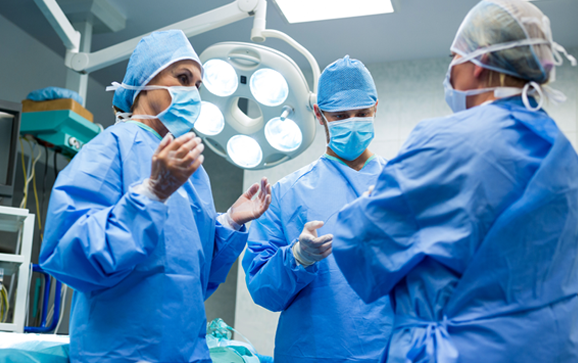St. Joseph Medical Center is hosting a free, virtual Back Pain Seminar Sept. 1 featuring Neurosurgeon William S. Rosenberg, MD. The Medical Center has invested in the 7D Surgical FLASH™ Navigation System for spinal procedures and is the first hospital in Kansas City region to deploy the technology.
Registration for the online back pain seminar can be found here:
Back Pain Seminar
As hospitals around the world look for new and innovative ways to improve surgical outcomes and patient safety, St. Joseph Medical Center took a leap into the future in April of this year with the installation the 7D Surgical FLASH™ Navigation System. This system virtually replaces standard fluoroscopy, providing the surgical team with a fast, accurate and radiation-free tool for the placement of spinal implants.
“St. Joseph Medical Center has always been proactive in ensuring that we have the right tools to protect our patients and enhance patient care, which is why we supported the purchase of the 7D Surgical FLASH Navigation System,” says Jodi Fincher RN, BSN, MBA, CCRN-K, FABC, Chief Executive Officer, St. Joseph Medical Center. “This investment is important and underscores our commitment to patient care and the communities we serve.”
The 7D Surgical FLASH Navigation System is the first and only platform that utilizes Machine-Vision Image Guided Surgery (MvIGS) technology. For the first time, spine surgeons can guide their tools to the critical anatomy using sophisticated camera technology linked to a computer in the operating theater. The underlying technology is similar to what is used in the latest self-driving automobiles. Unlike time-consuming conventional image guided surgery (IGS) systems that depend on intraoperative radiation, this new MvIGS technology can achieve an incredibly fast surgical workflow for spine procedures, reducing operative time for patients and eliminating unnecessary radiation exposure.
“As a spinal surgeon, the 7D technology is groundbreaking. It uses machine vision, software and advanced mathematics to provide me with game-changing information, allowing me to place hardware in the spine safely and accurately while minimizing surgical dissection—all because I can clearly see the entire anatomy in 3D,” says Dr. Rosenberg. “I am proud to be able to offer my patients the very latest technology in spine surgery while eliminating the unnecessary radiation still used in many hospitals.”
MEET MARIJEAN HALL
One of Dr. Rosenberg’s early patients was Marijean Hall, 72, of Overland Park,Ks. Marijean was just in her 20s when she first started having spinal problems. She was diagnosed with degenerative disc disease that only got worse over her lifetime. She underwent joint injections, but after a difficult childbirth delivery, her pain worsened to the point that several times she found herself on the floor and couldn’t get up. Combined with health problems including PTSD and Lyme Disease that went undiagnosed for three years, she credits sheer determination with getting her through her life.
When her first back surgery in April 2002 was unsuccessful, she lost the use of 80 percent of her left leg and was told to expect to use a cane for the rest of her life. But because she walked her dog daily for 3 to 4 miles, four months later, she walked 22 miles of a 26.2 mile marathon—with no cane.
Unfortunately, her back pain persisted. She had a second surgery three years ago but knew she would require more. When her surgeon suddenly passed away this year, Marijean was scheduled instead with Dr. Rosenbergat St. Joseph Medical Center.
On April 12, 2021, Marijean had her third back surgery—this time with the 7D (MvIGS) technology.
“My experience in one word? Fantastic!” Marijean says. “And it’s all because of the amazing outcome. When Dr. Rosenberg came in to see me the next day after surgery, and I was able to get myself up out of the bed, he was amazed. The surgery was extensive, involving my entire lumbar spine, so it was just a miracle.”
Marijean adds that her sister, Cenith, was by her side throughout the surgery and was also impressed with Marijean’s rapid recovery—along with the care she received at St. Joseph Medical Center.
“The nursing staff was so attentive and controlled my pain well, and everyone was impressed I was doing as well as I did,” Marijean says. “I would absolutely recommend this procedure and the care I received at the hospital.”
After surgery, Marijean’s daughter, Lauren, spent 10 days with her, and by the time she left, Marijean says she was able to completely take care of herself and her cockapoo, Ollie. After physical exercises in her own home and two follow-up visits at the hospital, Marijean was cleared for takeoff. So she traveled by plane to New York to enjoy visiting her daughter and three grandchildren, Maggie, 6, and twin grandsons, Brennan and Callan, 4.
“Honestly, I didn’t expect the surgery to be this successful with all of my health issues, many of them I’ve had since my 20s,” she says. “I guess it just took 52 years for the technology to catch up and for me to meet Dr. Rosenberg.”
St. Joseph Medical Center is hosting a virtual Back Pain seminar on Wednesday, Sept. 1, at 6 p.m. virtually. To register for the event, visit https://www.eventbrite.com/e/back-pain-webinar-new-7d-technology-for-spine-procedures-registration-166569057535


